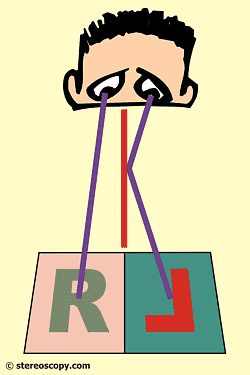

| Pigeon System |
 |
A fairly simple, yet efficient way to view stereoscopic images - even large format ones - is the so-called "Pigeon System". On November 16th, 1904, Léon Pigeon (a professor at the University of Dijon, France), applied for a patent to protect his invention. So how does his system work? Unlike Wheatsone's mirror-stereoscope, which used two mirrors, Pigeon's invention only needs one mirror. And therefore, only one of the images forming a stereo-pair (the one viewed through the mirror) has to be printed reversed or "mirror-inverted". The drawing on the left illustrates the basic principle: the observer views one image directly (in this case the right-eye view), the other one through a small mirror (in the example the left eye view). |
 |
|

| Back to the Stereoscopy.com FAQ Page |
